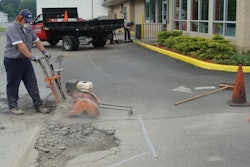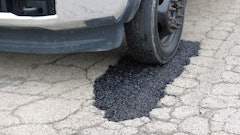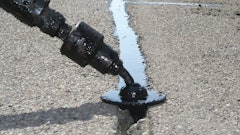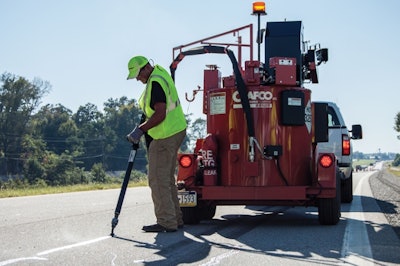
Generally, preservation treatments and pavement overlays are used to restore surface course characteristics such as smoothness, friction and aesthetics, or to add structural support to an existing pavement.
However, any preservation treatment needs to be placed on a structurally sound base. If an existing pavement is cracked or provides inadequate structural support, these defects will often reflect through even the best-constructed overlay and cause premature pavement failure in the form of cracks and deformations. To maximize the useful life of a pavement, failed sections of the existing pavements should be patched or replaced and existing pavement cracks should be filled.
Cracks are going to happen in asphalt pavement, and when they do it's your job to stop them from deteriorating the surface and creating potholes. Before proceeding with any type of surface treatment, consider these points about crack sealing as a preservation pretreatment.
What is it: Crack sealing is the placement of specialized treatment materials (crack sealant) above or into cracks to prevent the intrusion of water and incompressible materials.
Why crack sealing is needed: Cracking is a common and unavoidable type of damage found in asphalt pavement. The Asphalt Institute indicates that crack sealing is the single most important pavement maintenance activity. Sealing cracks promptly helps to prevent water penetration which can accelerate the deterioration of the pavement and result in potholes and base failures.
Where to do it: Crack sealing maintains a tightly sealed crack only as long as the pavement remains stationary and the pavement is structurally sound. In climates with extreme temperatures, where expansion and contraction of the pavement occurs often, resealing may be necessary every year. Sealing and filling should be done only on dry surfaces and when the temperature is above 40 F°. (Cooler temperatures cause the pavement to contract, opening the crack and making it easier to fill properly.) Traffic can be allowed on sealed cracks immediately if a detackifying agent is used, otherwise traffic should not be allowed on the sealed cracks until sealant has cured.
Why/when you should not crack seal: According to the Asphalt Institute, sealing and filling cracks should not be done on a pavement that has significant structural problems as crack sealing or filling does not provide any structural improvement to the pavement. If the pavement has base failures, severe rutting or fatigue (alligator) cracking, crack sealing/filling is not an appropriate preservation option.
Preservation prognosis: Crack sealing can extend the life of the pavement 2-5 years; can provide a 10 point sustained increase in Pavement Condition Index for 7 years vs. an untreated crack; can reduce potholes and secondary cracking; and can maintain pavement smoothness over a 5-year period vs. a pavement without crack sealing.Treating cracks prior to any surface treatment is vital to assuring the desired performance of the surface treatment. Crack sealing prior to surface treatments enhances the treatment and further extends the pavement life.
According to the Asphalt Institute, crack sealing is the single most important maintenance and pavement preservation activity. Many distresses can be related to the intrusion of water into the pavement structure and if the water is kept out of the pavement system, the majority of distresses can be delayed.
Crack Sealing as Pretreatment Improves Preservation Performance
Recently, the National Center for Asphalt Technology (NCAT) in Auburn, AL completed a study regarding the effects crack sealing has on the success of a preservation treatment. The comprehensive three-year study from 2012-2015 evaluated 25 different treatments. There were a variety of results, but in regards to crack sealing as a pre-treatment, the study found that:
- Crack sealing reduced development of interconnected cracking and reduced subgrade moisture levels
- Crack sealing as pre-treatment improved surface treatment results for chip seals and micro surfacing
The study used 25 different sections along with a control section to study each different treatment. The control in this study is defined as normal cracking as if NO treatment was applied. NCAT compared the results of the preservation treatments vs. the control.
The first section of notice for the study is Section L5, where NCAT applied only a crack sealing treatment to the pavement. The result is that after year one, the pavement had 100% less cracking than the control group and after year two, the pavement had 75% fewer cracks when compared to the control section.
NCAT also created sections of pavement that were to receive other preservation treatment methods. They compared those sections to both the control and to sections that received crack sealing as a pretreatment before the preservation treatment.
Section L6 received only a chip seal treatment. Compared to the control, the pavement had 100% less cracking at year one, but at year two, the treatment had 25% more cracking than the control group without any treatment.
The next section, L7, received a crack seal pretreatment and then the chip seal application. In this section, the pavement showed 100% less cracking in year one and 100% less cracking still at year two compared to the control -- just by adding crack sealing prior to the chip seal application.
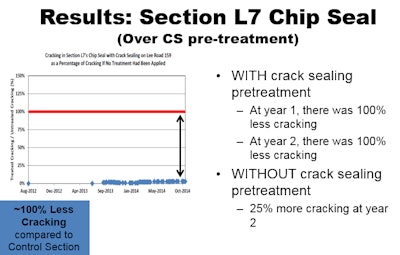 Section L7 received a crack seal pretreatment and then the chip seal application. In this section, the pavement showed 100% less cracking in year one and 100% less cracking still at year two compared to the control -- just by adding crack sealing prior to the chip seal application.
Section L7 received a crack seal pretreatment and then the chip seal application. In this section, the pavement showed 100% less cracking in year one and 100% less cracking still at year two compared to the control -- just by adding crack sealing prior to the chip seal application.
By completing crack sealing as a pretreatment prior to a chip seal, the pavement went from 25% more cracking with a chip seal alone at year two to 100% less cracking with a chip seal over crack seal pretreatment, showing that a small investment yields a large return.
The study then focused on micro surfacing as a preservation treatment option. Section L11 received a micro surface treatment with no crack sealing as a pretreatment. At year one, there was 50% less cracking. At year two, there was 15% less cracking than the control.
Section L12 comparatively received crack sealing as a pretreatment before the micro surface course. At year one, there was 90% less cracking and at year two, there was 60% less cracking compared to the control.
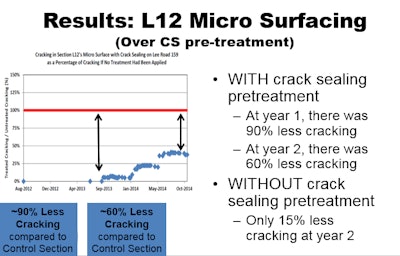 Section L12 comparatively received crack sealing as a pretreatment before the micro surface course. At year one, there was 90% less cracking and at year two, there was 60% less cracking compared to the control.
Section L12 comparatively received crack sealing as a pretreatment before the micro surface course. At year one, there was 90% less cracking and at year two, there was 60% less cracking compared to the control.
This shows that crack sealing as a pretreatment prior to micro surfacing results in 15% less cracking with micro surfacing alone to 60% less cracking using micro surfacing over crack seal pretreatment.
NCAT and other municipalities are continuing to study crack sealing as an inexpensive way to extend the life of the pavement. Crack sealing has demonstrated to be the lowest cost preservation treatment with the highest benefit to cost ratio and is one of the the best investments to protect pavement.
Crack sealing has been shown to extend pavement life more than five years while improving sealant service life, pavement service life, Pavement Condition Index (PCI) and pavement smoothness (IRI).







